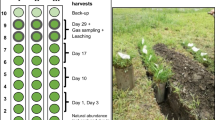Abstract
Most spoils in the Lusatian lignite district have been afforested successfully. However, since soil chemical status remains very different compared to unmined locations even after decades it is still unclear if forest ecosystems develop to a self-sustainable status or if restoration will fail in the long term. To clarify this question water and element fluxes of different-aged red oak(Q. rubra L.) stands on both Quaternary pure sands and Tertiary, pyritic loamy sands were investigated and compared to a nearby, unmined location. Due to increasing interception and evapotranspiration, the deep percolation rates of red oak forests decline drastically within30 yr. Annual groundwater recharge is about 300 mm yr-1(41–46% of precipitation) initially. Deep percolation of the older stands decrease to less than 15% of precipitation, independent of substrate type. Tertiary substrates are characterized by intensive leaching of H, Fe, Al, Mg, Ca, NH4-N and SO4-S due to pyrite oxidation and therefore enhanced silicate weathering. Despite of drastically declining output rates with progressing ecosystem development, they remain remarkably higher as compared to Quaternary sands. However, despite differences in soil chemistry, the aged stands act as an almost complete sink for N, P and K. Compared to adjacent oak forests on undisturbed soils the stands on reclamation sites show very similar patterns with regard to N, P, K, Ca and Mg turnover.
Similar content being viewed by others
References
Gärtner, E. J.: 1987, ‘Beobachtungseinrichtungen des Hessischen Untersuchungsprogrammes “Waldbelastung durch Immission - Wdl”’, Forschungsberichte der Hessischen Forstlichen Versuchsanstalt 1, 1–110.
Gast, M., Schaaf, W., Scherzer, J., Wilden, R., Schneider, B. U. and Hüttl, R. F.: 2001, ‘Element Budgets of Pine Stands on Lignite and Pyrite Containing Mine Soils’, J. Geochem. Explor. 73, 63–74.
Heinsdorf, D.: 1996, ‘Development of Forest Stands in the Lusatian Lignite Mining District after Mineral Fertilization Adapted to Site and Tree Species’, Water, Air, and Soil Pollut. 91, 33–42.
Heinsdorf, D.: 1999, ‘Düngung von Forstkulturen auf Lausitzer Kippen’, Technical Report, Lausitzer Braunkohle Aktiengesellschaft, Senftenberg, 54 pp.
Heinsdorf, D.: 2000, ‘Langjährige Auswirkungen mineralischer Düngungen in jungen Kiefernbe-ständen auf Kippsanden’, AFZ/Der Wald 21, 1138–1143.
Hüttl, R. F.: 1998, ‘Ecology of Post Strip-mining Landscapes in Lusatia, Germany’, Env. Sci. Pol. 1, 129–135.
Illner, K. and Katzur, J.: 1964, ‘Betrachtungen zur Bemessung der Kalkgaben auf schwefelhaltigen Tertiärkippen’, Z. Landeskultur 5, 287–295.
Jansson, P.-E.: 1991, ‘Simulation Model for Soil Water and Heat Conditions. Description of the SOIL Model’, Report 165, Swedish University of Agricultural Sciences, Department of Soil Sciences, Uppsala, 173 pp.
Katzur, J.: 1998, ‘Melioration schwefelhaltiger Kippenböden’, in W. Pflug (ed.), Braunkohlentage-bau und Rekultivierung: Landschaftsökologie - Folgenutzung - Naturschutz, Springer Verlag, Berlin, Heidelberg, New York, pp. 559–572.
Katzur, J, Böcker, L. and Stähr, F.: 2000, ‘Ertragskundliche Untersuchungen auf Rekultivierungs-flächen im Lausitzer Braunkohlenrevier’, in G. Broll, W. Dunger, B. Keplin and W. Topp (eds), Rekultivierung in Bergbaufolgelandschaften, Springer Verlag, Berlin, Heidelberg, New York, pp. 147–172.
Katzur, J. and Haubold-Rosar, M.: 1996, ‘Amelioration and Reforestation of Sulfurous Mine Soils in Lusatia (Eastern Germany)’, Water, Air, and Soil Pollut. 91, 17–32.
Knabe, W.: 1959, ‘Möglichkeiten zur Wiedernutzbarmachung der vom Braunkohlentagebau bean-spruchten Flächen’, Bergbautechnik 9(4), 173–182.
Knoche, D., Embacher, A. and Katzur J.: 2000, ‘Element Dynamics of Oak Ecosystems on Acid-sulphurous Mine Soils in the Lusatian Lignite Mining District (Eastern Germany)’, Landscape and Urban Planning 51(2-4), 113–122.
Schaaf, W., Gast, M., Wilden, R., Scherzer, J., Blechschmidt, R. and Hüttl, R. F.: 1999, ‘Temporal and Spatial Development of Soil Solution Chemistry and Element Budgets in Different Mine Soils of the Lusatian Lignite Mining Area’, Plant and Soil 213, 169–179.
Stähr, F., Katzur, J. and Böcker, L.: 2000, ‘Untersuchungen zur Nährstoffversorgung der Kiefernforsten auf Kippenstandorten des Lausitzer Braunkohlenreviers’, Beitr. Forstwirtsch. u. Landsch. ökol. 34(2), 56–62.
Thun, R., Herrmann, R. and Knickmann, R.: 1955, Handbuch der Landwirtschaftlichen Versuchs-und Untersuchungsmethodik (Methodenbuch), Neumann Verlag, Radebeul, Berlin, 271 pp.
Ulrich, B.: 1991, ‘Rechenwege zur Schätzung der Flüsse in Waldökosystemen - Identifizierung der sie bedingenden Prozesse’, Ber. Forschungszentr. Waldökosysteme (Univ. Göttingen), Reihe B 24, 204–210.
Vetterlein, D. and Bergmann, C.: 1999, ‘Ausbildung osmotischer Potentialgradienten zwischen Gesamtboden und Rhizosphäre - Vergleich zwischen einem 'salzreichen’ Kipp-Kohlesand und einem 'salzarmen’ Kipp-Sand’, Mitt. Dtsch. Bodenkundl. Ges. 91, 889–892.
Waschkies, C. and Hüttl, R. F.: 1999, ‘Microbial Degradation of Geogenic Organic C and N in Mine Spoils’, Plant and Soil 213, 221–230.
Author information
Authors and Affiliations
Corresponding author
Rights and permissions
About this article
Cite this article
Knoche, D., Embacher, A. & Katzur, J. Water and Element Fluxes of Red Oak Ecosystems during Stand Development on Post-Mining Sites (Lusatian Lignite District). Water, Air, & Soil Pollution 141, 219–231 (2002). https://doi.org/10.1023/A:1021350321058
Issue Date:
DOI: https://doi.org/10.1023/A:1021350321058




